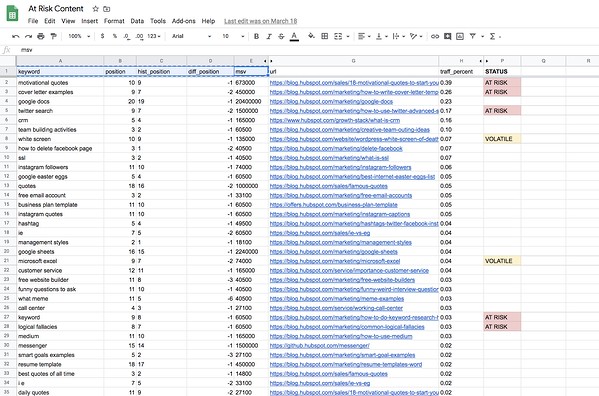After months of working on a marketing campaign, nothing's worse than realizing you aren't seeing the results you expected.
Unfortunately, many of us have been there. We've put all of our creative effort, time, and numerous resources into a campaign that sounded like a great idea, but had nowhere near the expected ROI or engagement. Then, on top of watching our project fail, we've had to deal with the awkward scenario of sharing bad performance data with our teams.
No matter how hard you try, it's impossible to know exactly how well a campaign will do before you run it. However, there's a strategy that gets pretty close.
It's called predictive marketing.
While predictive marketing sounds like some futuristic technology you'd only see on a show like Westworld, using data to estimate an outcome isn't new.
Predictive marketing is fueled by predictive analytics, which dates back to the 1930s. It enabled mathematicians and computers to calculate and analyze the possible successes, failures, and results of various scenarios -- such as health or weather conditions.
Later, in the 1990s, when analytics tools became more available to brands, marketers at companies like eBay and Amazon began to combine marketing data with similar formulas or algorithms to predict and strategize around potential consumer behaviors, purchases, and marketing campaign performance.
In the early 2000s, with the presence of "Big Data" many more brands and online advertising platforms embraced predictive analytics and marketing technology.
Now, predictive marketing is all around us. Below are just a few common instances of it, along with explanations of how brands can leverage it.
Examples of Predictive Marketing
1. Predictive Product Suggestions
Have you ever considered buying a product, researched it, and then saw the same product -- or a very similar one -- in a promotion that showed up on a social media feed, in your email inbox, streaming platform, or another website's banner? You're not alone.
Ecommerce site algorithms regularly collect data about your product interests based on what you've viewed or purchased from them. Then, these algorithms use that data to predict which products you're most likely to buy next. This data is then used in the ecommerce ad or promotion a prospect sees.
Need an example? Below is an EyeBuyDirect ad that appeared on my Facebook News Feed.

As an EyeBuyDirect customer, I've bought many pairs of glasses with similar styles, shapes, or patterns to the pairs seen in the ad above. To compare, here are two of my recent purchases:
If I needed new glasses, EyeBuyDirrect's ad would be very appealing to me because it shows product offerings I'm very likely to view or buy.
Rather than presenting the same ad or product to every audience member, predictive marketing tools can help you to direct customers to products they might be most interested in.
If you're planning to bring your business online and want to use predictive marketing to make more sales, several affordable ecommerce tools enable you to send predictive product suggestions to your audiences. You can learn more about them here.
2. Predictive Lead Scoring
Predictive marketing doesn't just stop after you get a contact, customer, or lead.
Once you build up your list of contacts, you'll want to continue marketing to them or potentially direct them to a sales rep. But, if you try to market your brand continuously to every single one of your new contacts, you might waste serious time if they aren't serious about buying your product or signing up for more content.
To avoid giving too much time to unqualified leads, brands can use tools like HubSpot's Predictive Lead Scoring feature to analyze contact data profiles and estimate which prospects are most likely to make a deal in the future.

When you have a huge database of contacts with varying levels of interest in your product, brand, or service, predictive lead scoring data like that above can give you insight on which prospects to prioritize in your marketing or sales efforts first. In turn, this could give you a leg up on brands that waste crucial time and resources on deals that never happen.
3. Automated Social Media Suggestions
A handful of social media tools, including HubSpot Marketing Hub, use predictive analytics and audience data to estimate and suggest the best times to post your content on a given channel.
On top of simple content timing suggestions, some tools go even deeper with social media content predictions. For example, when social media managers upload two or more images to the social media scheduling tool, Cortex, the platform will use historical data to determine which photo's colors will be most eye-catching to followers.

On top of the social media tools that can suggest strategies based on predicted outcomes, social channels like Facebook, Twitter, and Pinterest also offer some predictive tools within their ads platforms.
For example, in 2018, news outlets obtained documents from Facebook revealing that it secretly launched a "Predictive Loyalty" feature within its ads. The feature reportedly analyzes Facebook user behavior, interests, page likes, and other data points to circulate ads to people that had the highest likelihood of clicking them, rather than just directing ads to a brand's audience targets.
Since Facebook's predictive advertising news, Twitter's also acknowledged that it uses predictive ad algorithms specifically for movies, TV, and entertainment-related promotions.
Aside from predictive ad targeting, social platforms like Facebook and Pinterest also use algorithms to make predictions related to multivariate or A/B testing. With these types of tests, a brand will often submit two or more variations of their ad. When the ad goes live, the social media platforms will immediately analyze which variation is clicked on the most and predict which will have the best conversion outcome. From there, social media ads will begin to display the winning variation.
4. Customer Churn Prevention Tools
While many marketers focus primarily on gaining new customers, some might focus on creating content and offerings that continue to engage, retain, and even upsell current customers.
But, sometimes, it can be hard to tell when customers need new, engaging content or when they're likely to churn. That's why some major companies have implemented predictive analytics as well as marketing strategies to identify and re-engage customers that are about to churn.
Take Sprint for example. Back in 2014, when the cell-phone giant saw an all-time high customer churn rate, marketers and service reps began to use predictive analytics tools to determine which customers were most likely to cancel their service. Once they did this, they were able to target those customers with re-engagement communications, messaging, and special offers that would keep them signed up.
According to a case study, Sprint's predictive strategy led to a 10% decrease in customer churn, and an 800% increase in upgrades within 90 days of implementation.
While your brand might not be able to implement complex, customer churn prediction tools, there are other ways you can use data to predict and prevent lost audiences.
For example, by tracking email engagement data and which contacts are less likely to open or click on emails, you can create a list segment of contacts that are at-risk of unsubscribing and send a re-engagement email like the one below:

5. Predictive SEO Tactics
As a marketer, a major part of your job might involve creating blog posts, web pages, or other online content aimed to attract and convert audiences. Because search engines can provide major traffic wins and brand awareness to brands, you'll likely want to produce valuable content that shows up on page one.
But, once you've landed your high search result page position and gained solid organic traffic, you can use predictive data to prevent the future loss of your ranking and all the traffic that comes with it.
This process, called predictive SEO, is when content strategists use traffic and search ranking analytics to determine if a web page is at risk of losing its traffic momentum from search engines.
For HubSpot, our predictive SEO process involves using our At-Risk Content Tool -- which analyzes data from SEMRush, Ahrefs, and other software -- to determine when we're losing our ranking on search engine pages.
For example, if one of our posts shows up in the first spot on a Google search result page, then steadily goes down to spot three or four, our At-Risk Content Tool might flag the post as in danger of losing search traffic.
Here's what our At-Risk Content spreadsheet looks like. When a blog post begins to see declines that could potentially continue, a formula in the spreadsheet notes the blog post as "At-Risk" in the Status column on the right:

If you're a marketer who focuses primarily on web content, creating a strategy like this can proactively help you monitor the performance of many web pages at once, learn when old content really needs an update, or identify old content strategies or formats that need to be re-worked -- all before you lose major search traffic.
Want to replicate the predictive SEO strategy above? Here's a detailed post with the full step-by-step process we used.
What to Know When Using Predictive Marketing
While predictive marketing can be a handy tool for justifying a new tactic or strategy, there are important things marketers should keep in mind if they want to leverage it.
- It's not perfect: Even if an algorithm or marketing formula seems to give accurate estimates 99% of the time, the fact that marketing strategies rely on human engagement to succeed can cause a prediction to be wrong. While you can use predictive marketing data to justify investments or proposed strategies, you should have a plan for what to do if unexpected results occur.
- It can be pricey: While some predictive tools, such as HubSpot, can be affordable and easily accessible to smaller brands, other tools and predictive marketing projects that require analyzing large amounts of data can get costly. Be sure to start with scaleable affordable predictive tools or tactics first.
- It requires data: While some tools, such as ad or SEO software have access to historical consumer data, creating your own predictive marketing strategy from scratch might require you to have your own data set. Collecting, cleaning, and organizing this data so a predictive tool or algorithm can leverage it can take quite a lot of time which should be built into your predictive strategy.
Want to learn more about how predictive analytics and data can fuel your marketing strategy? Click here for a handy blog post, or download the free resource below.
